As the name suggests, White Stew is a white coloured stew made from béchamel sauce. It’s so colourful with the chicken, carrots, potatoes, onions and green peas in it. This stew is also called ‘Cream Stew’ although no cream is added to the sauce.
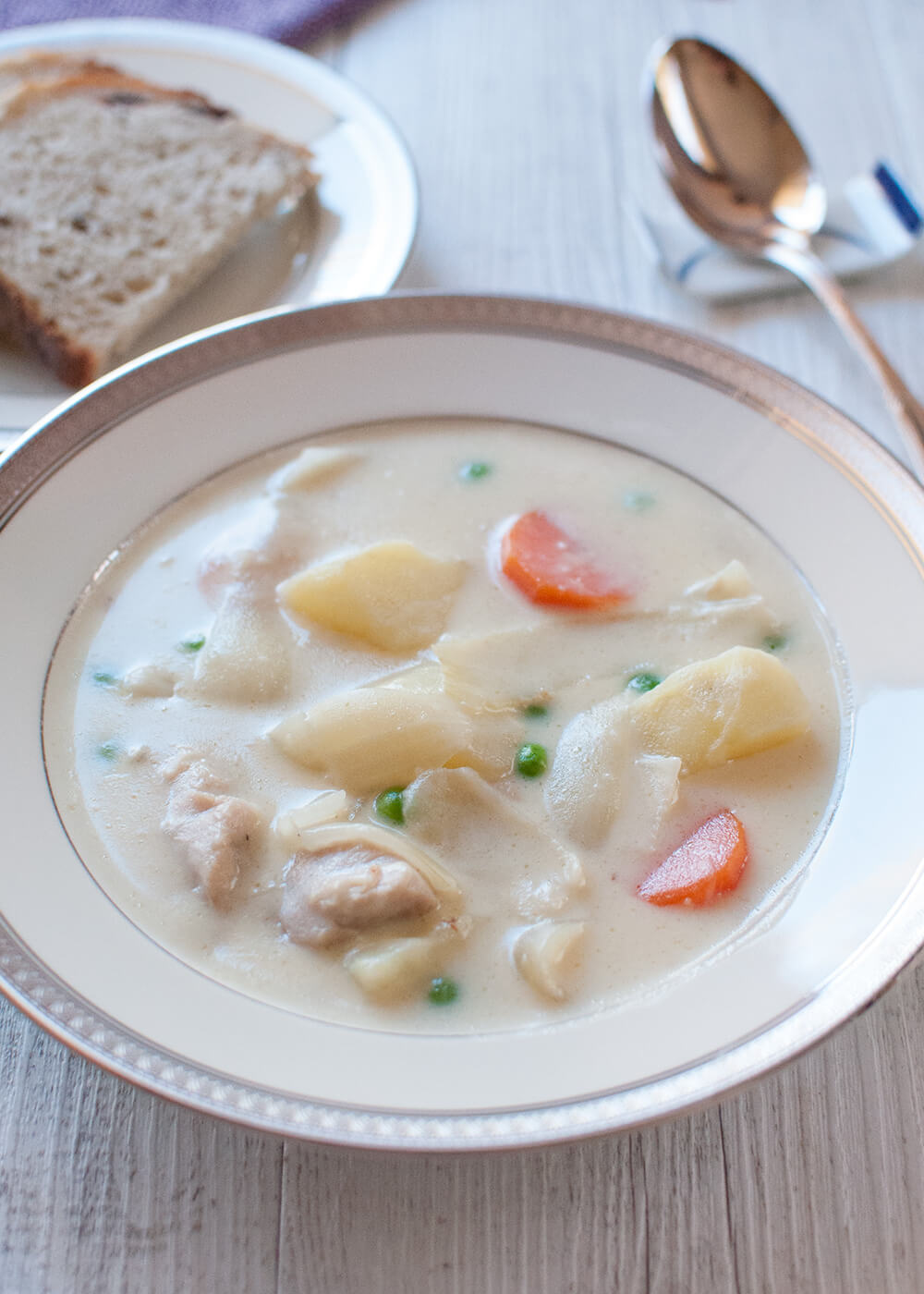
White stew (also called cream stew) is one of the Western-influenced dishes of Japan. It is a very popular home cooking dish, particularly among families with young children. I remember cooking white stew regularly when my kids were school-aged.
In Japanese, white stew is pronounced as ‘howaito shichū’ (ホワイトシチュー), and cream stew is ‘kur ī mu shichū’ (クリームシチュー). You see, the Japanese language does not have an equivalent sound to ‘t’ or ‘s’. So, ‘t’ often becomes ‘to’, e.g. the word ‘train’ will be pronounced as ‘torein’, and ‘s’ becomes ‘shi’ or ‘su’. Actually, instead of saying ‘shichū’, some Japanese people say ‘suchū’, which is closer to the English sound.
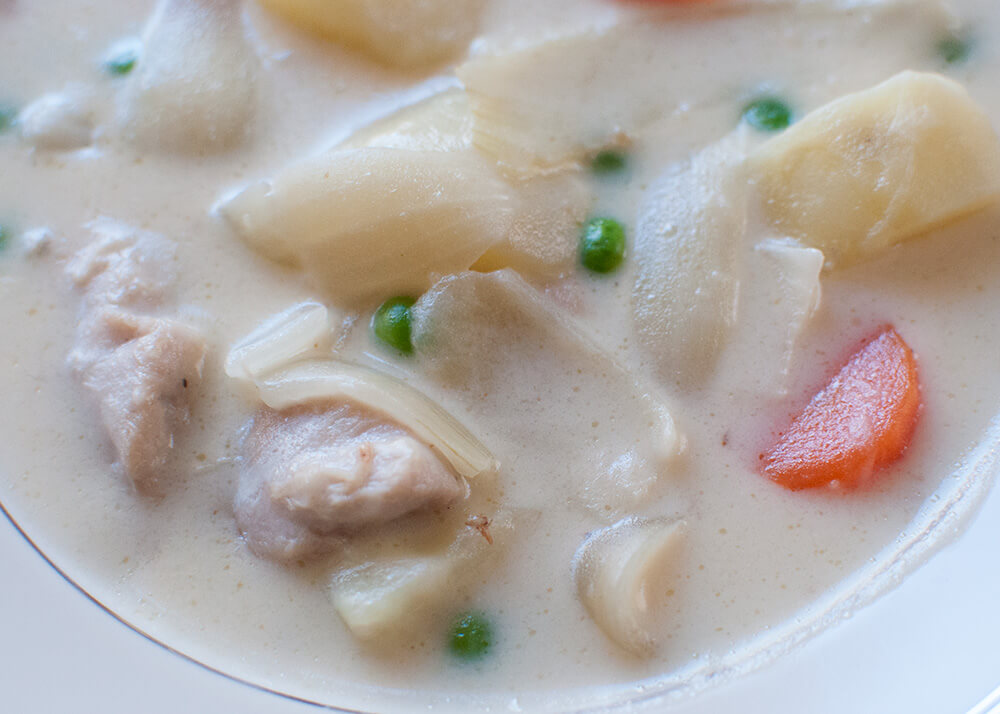
The name ‘white stew’ appeared in 1947 when Japanese schools served the stew with skim milk added to it. To recover from lack of nutrition during the war, the government encouraged schools to use skim milk in the school lunches (Japanese public schools provide lunches!) to supplement calcium for children. As the colour of the stew was white, it was called white stew or cream stew (probably because it was thick and creamy).
About 20 years later when the famous food brand House Foods Corporation introduced cream stew roux in granular form in a pack, white stew became the popular winter dish in Japan. This was also the time when the name ‘cream stew’ became more dominant than ‘white stew’.
The way to use the roux is very similar to the curry roux that I talked about in my post, Katsu Curry (Japanese Curry with Chicken Cutlet). Sauté meat and vegetables, add water and cook, then mix in the roux.
You can buy cream stew roux in a pack at Asian/Japanese grocery stores. You may find not only House Foods brand but also S&B and even other brands. The photo below shows a pack of cream stew roux by House Foods.
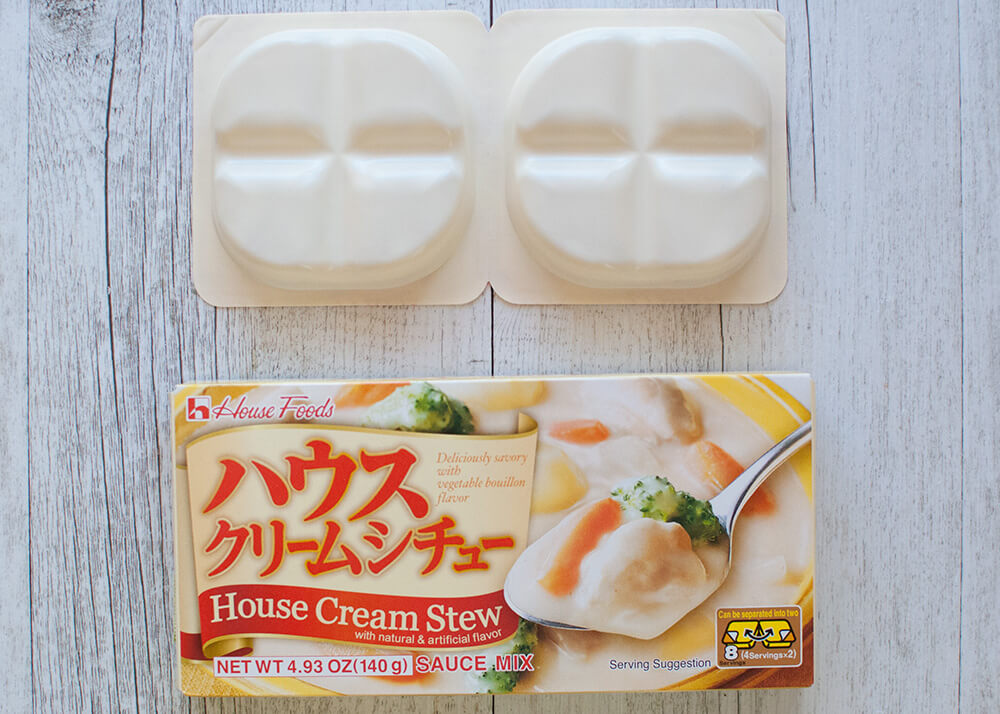
The entire pack serves 8 but the block of roux is wrapped into two separate pieces and partitioned into 4 within each wrap. So it is easy to make stew for a smaller number of people.
When I was working and my children were still little, I sometimes bought a pack of cream stew roux from the Japanese grocery stores and made white stew (I mean cream stew) for dinner. But sometimes I made white stew from scratch using today’s recipe. It takes a little more effort to cook as you need to make béchamel sauce, but I find that the flavour is much nicer than the instant roux.
Although it is also called ‘Cream Stew’, this White Stew does not use cream at all. No cheese, either. The thick white sauce is made from béchamel and milk. Come to think of it, I cannot think of any stews other than this Japanese White Stew whose sauce is made of thickened milk.
The way I make béchamel sauce is different from Nagi’s method. She uses more butter to the amount of flour and cooks the flour for only a short period of time before adding milk to it. My method of making béchamel sauce needs a bit more time to cook the flour in butter before adding milk and there are a few key points.
THREE KEY POINTS OF MAKING BÉCHAMEL SAUCE
- Cook flour in butter for 7-8 minutes until the flour becomes watery and the nutty fragrance comes out.
- Reduce the temperature of the watery flour before adding milk.
- Add room temperature or warm milk in batches.
Since I use less butter, the flour and butter mixture is quite dry. But when the flour is cooked for 7-8 minutes at low temperature, it changes the chemical composition and becomes wet (see the bottom photo below). You will also notice nutty fragrances coming out. At this point, the consistency becomes similar to Nagi’s method of mixing more butter to flour, and you are ready to add milk.
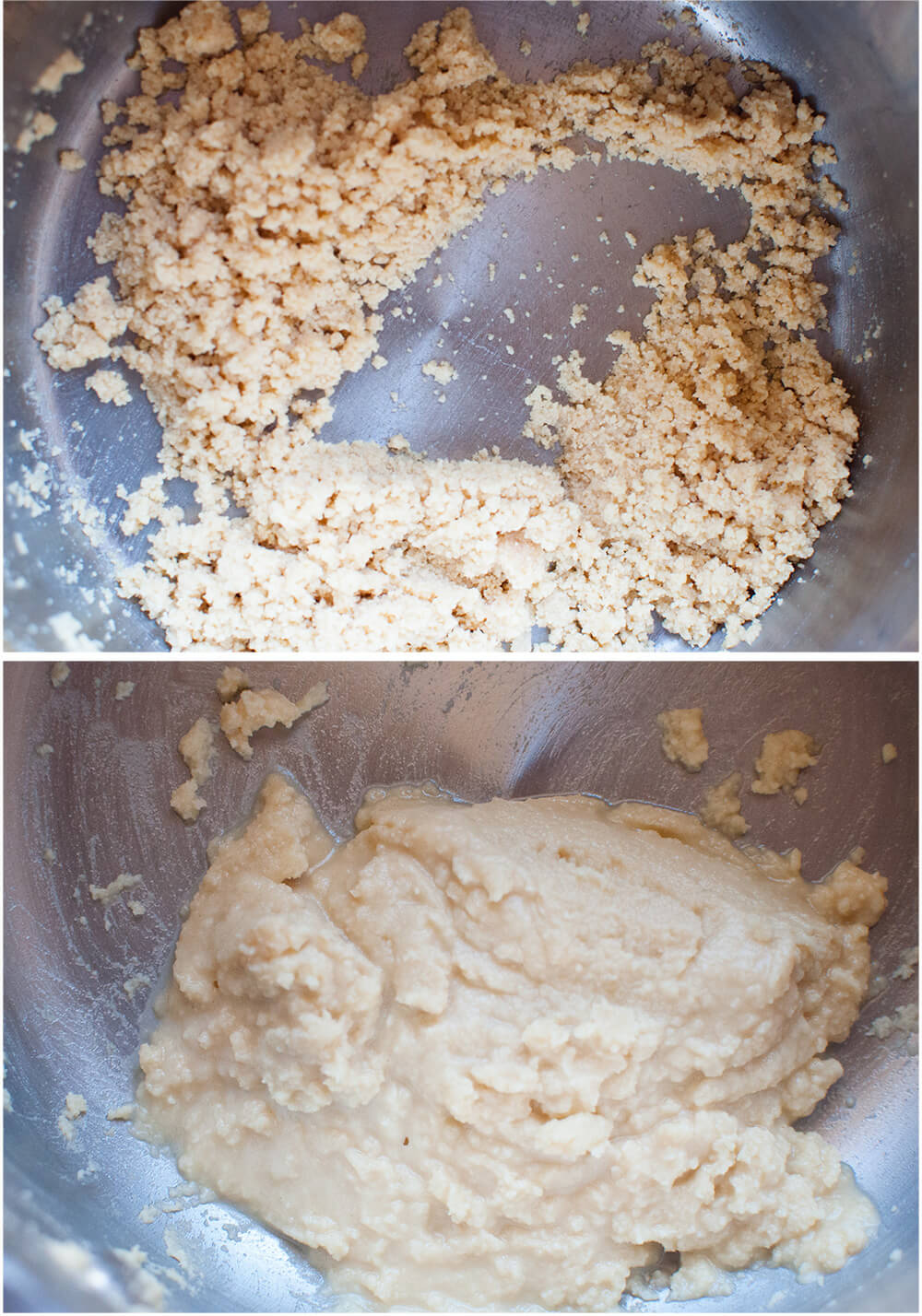
Flour and butter mixture is rather dry at the beginning (top) but after 7-8 minutes of heating, it will become wet (bottom).
Before adding milk, I place the saucepan on a wet towel to reduce the temperature of the pan. This will prevent the milk from bubbling when added to the saucepan.
Instead of adding milk all at once, add milk in batches. Ensure in each batch the béchamel mixture is lump free by mixing well over low heat. Using this method, it is quite possible to make smooth béchamel sauce without using an egg beater to remove lumps. But if lumps are there, feel free to use an egg beater.
STEW INGREDIENTS
Ingredients to go into the stew can vary but potatoes, carrots and onions are the most common vegetables. Popular meat used in white stew is chicken but I sometimes use pork. It is rare to use beef in this recipe, probably because the colour of the meat is too dark for the white roux. Besides, beef stew is also popular among Japanese people so beef has its own place.
I added green peas at the end to give another colour to it but I sometimes use broccoli florets or chopped green beans instead. Instead of cooking broccoli florets or green beans together with other vegetables, I blanch them separately and throw them in at the end like the green peas.
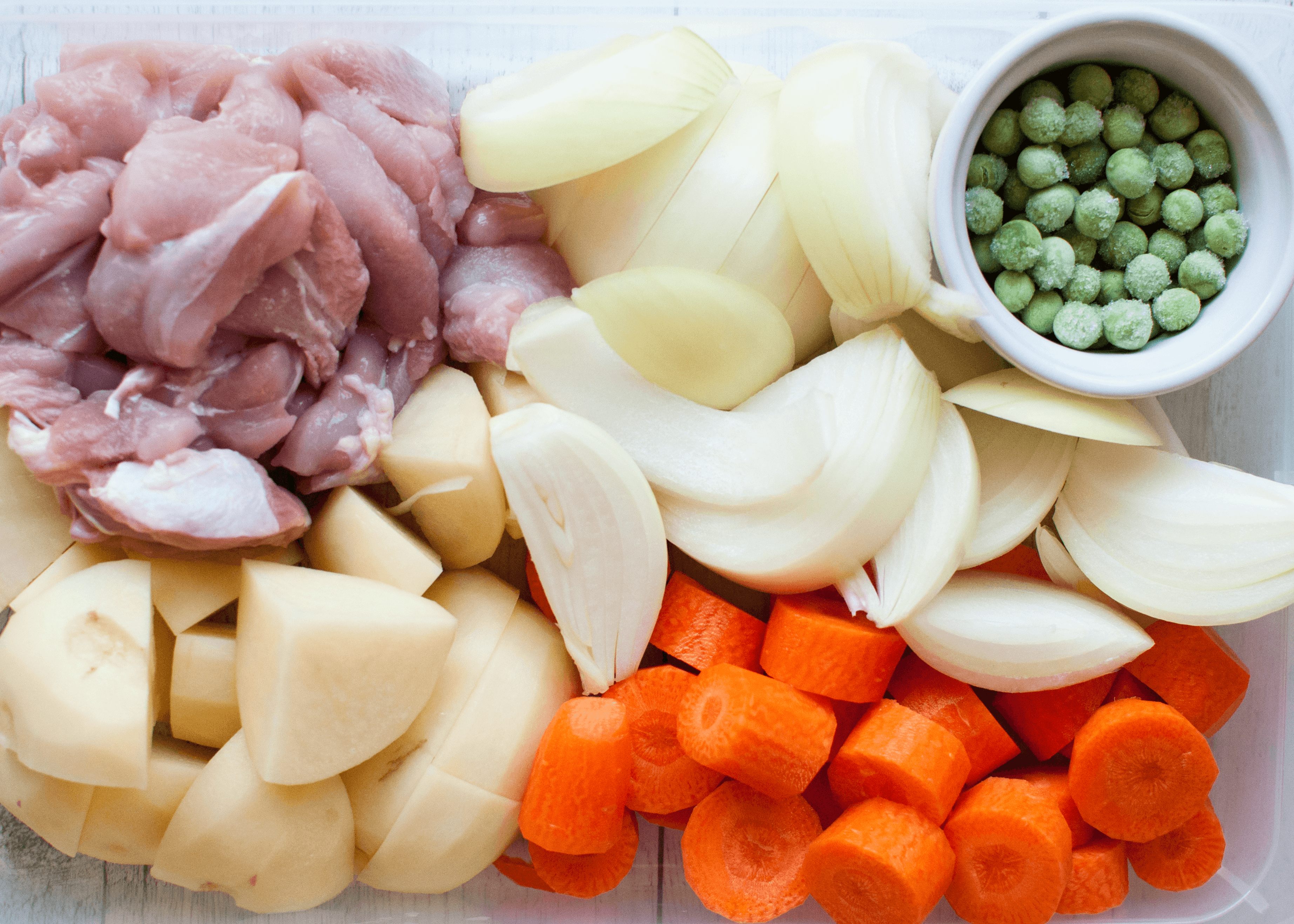
It is also common to add button mushrooms, which makes the stew more of a Western style dish. I once added shimeji mushrooms instead of button mushrooms and they were great too. I don’t think I would use shiitake mushrooms for this. I think shimeji would be the best for this stew if you were to use Japanese mushrooms.
White stew has developed over time in Japan to suit to people’s palette, which is more Westernised these days. House Foods introduced Hokkaido Cream Stew, which contains corn and cheese. It would be much richer than the original cream stew. They called it ‘Hokkaido’ because Hokkaido (northern island) is famous for its production of corns and cheeses.
White Stew is a hearty winter dish. It is not heavy with cream and cheese but it is light and tasty. The weather in Australia is getting warmer day by day but the temperature is still ok to have stew for dinner, I think. Northern hemisphere countries are heading towards winter and today’s recipe would be perfect on a cold night.
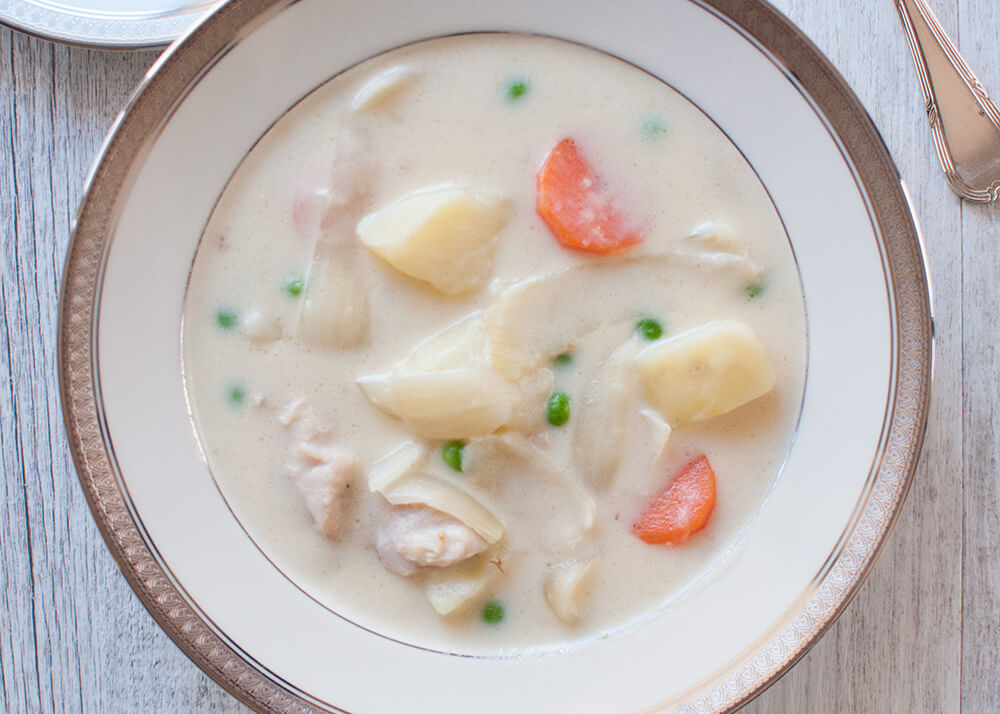
Yumiko![]()

This is a white coloured stew made from béchamel sauce. It’s so colourful with the chicken, carrots, potatoes, onions and green peas in it. This stew is also called ‘Cream Stew’ although no cream is added to the sauce and it is not as heavy as it might look.
- 300 g (0.7lb) chicken , diced into bite size pieces
- 160 g (5.6oz) carrot , cut into 1.5cm (⅝") thick discs (note 1)
- 300 g (0.7lb) potato , cut into large bite size pieces (note 2)
- 200 g (7.1oz) onion , cut in half, then sliced into 1.5cm (⅝") wide pieces
- 3 tbsp frozen green peas (note 3)
- 1 tbsp oil
- salt and pepper
- 2 cups chicken stock
- 2 bay leaves
- 30 g (1.1oz) butter
- 40 g (1.4oz) flour
- 2 cups milk (room temperature or warm)
- 2 tsp salt
- Freshly grated nutmeg (few sprinkles) or a pinch of nutmeg powder
-
Add oil to a large pot over medium low heat. Add chicken, salt and pepper and sauté for about 1 minute until surface of the chicken pieces are cooked.
-
Add onions and carrots. Sauté further 1 minute, then add potatoes.
-
Stir quickly to mix potatoes with other ingredients, then add stock to the pot. Add bay leaves and bring it to a boil over high heat.
-
Turn the heat down to low and simmer for about 10 minutes (note 4) until carrots and potatoes are cooked through.
-
Pour the béchamel sauce into the pot and mix gently. Add peas and mix.
-
When the stew starts boiling, turn off the heat. Serve while hot.
-
Melt butter in a sauce pan over low heat. Add flour and constantly stir with a wooden spatula so as not to burn.
-
Cook for about 7-8 minutes until the mixture becomes slightly moist.
-
Remove the saucepan onto a wet towel to reduce the heat of the pan quickly.
-
Add about ¼ of the milk and put it back on the stove over low heat. Mix quickly.
-
As it starts thickening, add another ¼ of the milk and mix. You may want to use egg beater if you see lumps of flour at this point.
-
Add ¼ of the milk again and mix ensuring there are no lumps. Add the rest of the milk, salt and nutmeg and mix well.
1. My carrot was not very thick so I cut it into discs. If your carrot is fat, cut it in half or quarter vertically, then chop.
2. My potatoes were medium size potatoes. I cut them into quarters lengthways, then cut each quarter into three perpendicular to the first cut. This made 12 large bite size pieces from each potato.
3. You can use fresh peas if you like. Fresh peas need to be precooked so that you can add them at the end. Quickly cool down the peas after boiling to retain the bright green colour. If you cook them together with other vegetables, the bright green colour will be lost.
Alternatively, you can use broccoli florets or chopped green beans. They should also be pre-cooked.
4. Time taken to cook varies depending on the size of the vegetables.
Loved this recipe!! I used prepackaged bullion cubes to make the chicken stock, only salting the veggies a bit, and adding the right amount of salt to the bechamel – but my soup ended up way saltier than it should be. Still good enough to enjoy, but don’t make the same mistake I did! I’ll use half a bullion cube next time.
Hi Lindsey, good luck next time!
This is chicken pot pie without the crust.
As delicious as chicken pot pie, I hope.
I made this today and it’s delicious! I adjusted the recipe to make it vegan, so I omitted the chicken, replaced the chicken stock with vegetable stock, and subbed oat milk and non-dairy butter. I was out of carrots and peas so used what I had, parsnips and cauliflower. It came out great! This recipe is easy to follow and unbelievably good. I will be making this again and again. Thank you for this awesome recipe!
Hi Chris, that’s great! You substituted with the right vegetables. They all go very well with the white creamy stew.
This was fantastic! Thank you for posting.
I had only half a box of Japanese instant House Cream Stew which wasn’t going to be enough for my 600g chicken thigh fillets and I didn’t feel like going to the shops just for that. A quick google search brought up your site and I was so pleased as I knew it would work for my Japanese style cream stew.
So I essentially doubled your recipe but made only one batch of your bechamel sauce and added it after I’d put in the bit of commercial roux and I didn’t worry about adding any extra milk that the boX roux called for. I also subbed one cup of stock for 1 cup box Chardonnay. Best Japanese cream stew ever . Will make from scratch from Now on!
Hi Anthea, you were smart to combine the two and get the best out of it! I am glad you enjoyed it. Making from scrach might give you a bit different flavour to House cream Stew but it should be a delicious.
I have actually made this before. I use broccoli instead peas, and potatoes instead of onions, as I am allergic to onions. It’s one of my favorite dishes to make. It’s wonderful when it’s cold and for when I work long weeks with late shifts. I just pop the pan back on the stove to heat it up.
Hi Destiny, yes, it’s a perfect dish on a cold day and handy to have in the fridge like you said.
Can I add pepper to it ?I like my food a little spicy
Hi Faith, do you mean red or green chilli? I have never tried it. It might work better with more white pepper.
Hi Yumiko,
I just finished making the dish. It’s an interesting delicious taste!
Thanks for the recipe.
Greetings, from the Netherlands.
Hi Elise, I am glad you enjoyed it!
I have made this recipe with my husband over ten times and it is always amazing. Thank you, Yumiko!!! おいしいです。
Hi Nicole, that’s great! ありがとう。
I worked as an ALT for english in three elementry schools. This recipe is one of my best dish I tried for a school lunch. Good thing i got the recipe now.I couldn’t contain my excitement to cook it this weekend. Looking forward to come out with the same tastiness. Thanks Yumikosan..
Hi Neil, it must have been a wonderful experience to teach English in the elementary school. I hope my stew is as good as the one you tried at school.
Pleas let me know what you think.
This looks wonderful! i’m planning on making it for my family but was wondering if there was a way i could substitute some chopped mushrooms in place of the peas?
Hi Lu, of course you can! You may want to sauté the mushrooms together with other vegetables.